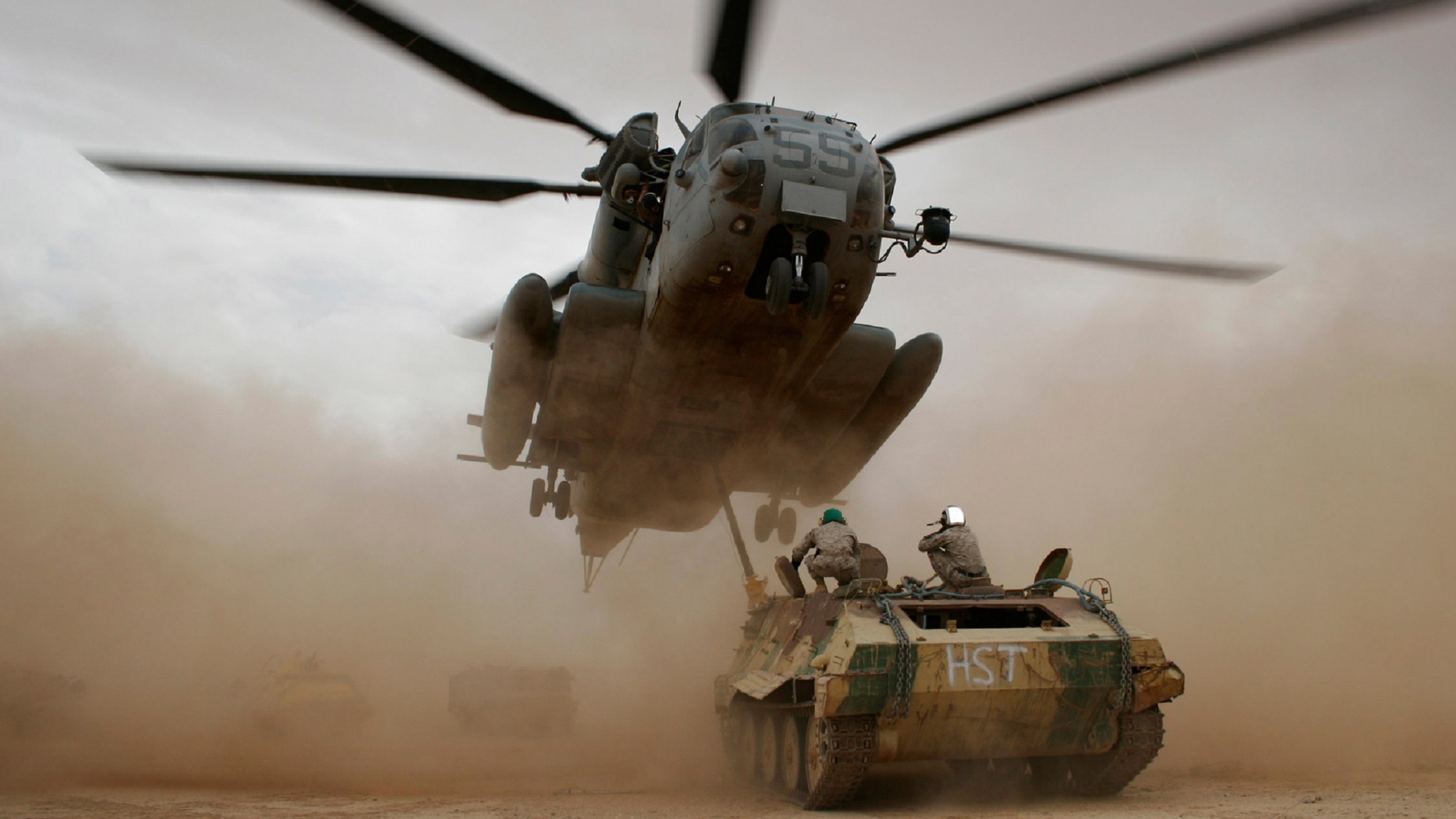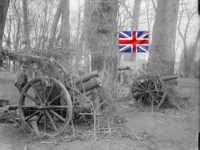The QF 4,5-inch howitzer was the standard howitzer of the British Army and accounted for 25% of all British guns during World War I.
During the Second Boer War from 1899 to 1902, the Boers used guns from Krupp of the German Empire. The British troops had to recognize that their guns and tactics were outdated. This finding was also evident in 1904 during the Russo-Japanese War, where British observers were present.
Thus, from 1901, a committee was founded, which had the task to elaborate the requirements of modern guns and its use and to introduce the British High Command. Various proposals were submitted by the companies who submitted their designs and a comprehensive examination of the 12cm Krupp gun captured during the Boer War was carried out. Although the purchase of guns from the German Empire was discussed, this proposal was rejected to strengthen its own economy.
Finally, in 1906, Coventry Ordnance Works came up with a satisfactory concept. In 1908, the prototype was tested and produced in large numbers with some subsequent changes.
With the outbreak of the First World War, each infantry division was equipped with a howitzer brigade of the Royal Field Artillery, so that the gun was used on all front sections. The entire war produced 3.177 guns, which was 25% of all British guns.
After the First World War, the gun remained in the service of the British army, except for a few modifications unchanged.
During World War II, the QF 4,5-inch howitzer was used by the British Expeditionary Force in northern France against the German Wehrmacht. In addition to the British troops, Australia, Canada, New Zealand and South Africa received a small number of their own troops. In addition to northern France, the British troops used the gun in North Africa while the Australian and New Zealand troops in Asia used it against the Japanese troops. Also the Wehrmacht fell into the hands after the retreat of the British troops in northern France some guns, which were then integrated as 11,4 cm leFH 361 guns.
Data sheet:
| Designation: | QF 4,5-inch Howitzer |
| Country of Origin: | Great Britain |
| Year: | 1908 |
| Number of pieces: | 3.359 pieces |
| Caliber: | 114 mm |
| Tube length: | 1,78 meters |
| Reach: | Max. 6.700 meters |
| Mass: | 1,37 tons |
You can find the right literature here:
British Artillery 1914–19: Field Army Artillery (New Vanguard)
In 1914 the artillery of Britain's 'Field Army' encompassed those weapons judged to have sufficient mobility to keep up with troops in the field. This book describes all major variants, from the 60-pdr guns of the heavy field batteries, perched somewhat uncomfortably on the cusp between field artillery and siege artillery, to the 2.75in. guns of the mountain batteries, almost toy-like in comparison. Between these two extremes lay the bulk of the artillery of the Field Army: the 13-pdr guns of the Royal Horse Artillery, and the 18-pdr guns and 4.5in. howitzers of the Royal Field Artillery batteries.
British Artillery 1914–19: Heavy Artillery (New Vanguard)
World War I is often deemed to have been 'a war of artillery', and British heavy artillery played a vital part in destroying the German trenches and providing invaluable cover for advancing troops on the Western Front. This book details the huge guns of the Royal Garrison Artillery, including the 6-in. siege gun and howitzer, the 8-in. howitzer, the 12-in. railway and siege howitzer and the infamous 9.2-in breech-loading siege howitzer. Camouflage and enemy battery locations and transport are covered, as well as tactics used and how the guns were developed and manned.
Artillery in the Great War
Artillery was the decisive weapon of the Great War - it dominated the battlefields. Yet the history of artillery during the conflict has been neglected, and its impact on the fighting is inadequately understood. Paul Strong and Sanders Marble, in this important and highly readable study, seek to balance the account.Their work shows that artillery was central to the tactics of the belligerent nations throughout the long course of the conflict, in attack and in defense. They describe, in vivid detail, how in theory and practice the use of artillery developed in different ways among the opposing armies, and they reveal how artillery men on all sides coped with the extraordinary challenges that confronted them on the battlefield. They also give graphic accounts of the role played by artillery in specific operations, including the battles of Le Cateau, the Somme and Valenciennes.Their work will be fascinating reading for anyone who is keen to understand the impact of artillery
World War I Battlefield Artillery Tactics (Elite)
From the beginning of 'trench warfare' in winter 1914/15, artillery became the absolutely dominant arm in all the major armies for the rest of World War I, to a degree never seen before or since. The numbers and capabilities of the guns and ammunition available governed all the generals' battle plans; and the ways in which they were employed, and either succeeded or failed, decided the outcome of battles. The majority of the millions of casualties suffered during the war fell victim to artillery fire.
The artillery war fell into three distinct phases along a four-year learning curve (with the necessary equipment and training for the second and third phases always lagging behind the tactical needs). The war began with mostly light, mobile artillery equipped and trained to support fast-moving infantry and cavalry by direct fire, mostly with air-bursting shrapnel shells.
The entirely unexpected end of the first campaigns of manoeuvre as the armies bogged down in static trench warfare found both sides ill equipped and ill trained for what was in essence siege warfare on an industrial scale. This demanded more and heavier guns and high-explosive shells, and more complex skills for indirect fire - observation on the ground and in the air, locating targets (including enemy artillery), dropping the right kind of shells on them, the communications needed for co-ordinating the work of hugely increased numbers of guns, and getting many millions of shells up to them for week-long bombardments. These seldom worked as anticipated (classically, by failing to 'cut the wire' or to penetrate deep bunkers); so innovative officers on both sides worked to devise new tactics, with more versatile mixes of ammunition (e.g. gas shells, smoke shells, star shells and so on) and more imaginative ways of using them, such as box barrages and creeping barrages.
Finally, in early 1918, the static slogging broke down into a renewed phase of manoeuvre warfare, made possible by sophisticated co-operation between artillery and infantry, plus the newly important air and mechanised forces. The lessons that were finally learned shaped the use of artillery worldwide for the rest of the 20th century.
Fully illustrated with period photographs and specially drawn colour artwork and drawing upon the latest research, this engaging study explains the rapid development of artillery tactics and techniques during the conflict in which artillery played a pre-eminent role - World War I.
This post is also available in:
 Deutsch (German)
Deutsch (German)  Français (French)
Français (French)  Italiano (Italian)
Italiano (Italian)  简体中文 (Chinese (Simplified))
简体中文 (Chinese (Simplified))  Русский (Russian)
Русский (Russian)  Español (Spanish)
Español (Spanish)  العربية (Arabic)
العربية (Arabic)
















